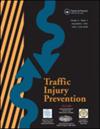An integrated framework for driving risk evaluation that combines lane-changing detection and an attention-based prediction model
IF 1.9
3区 工程技术
Q3 PUBLIC, ENVIRONMENTAL & OCCUPATIONAL HEALTH
引用次数: 0
Abstract
Objective
In recent years, the increase in traffic accidents has emerged as a significant social issue that poses a serious threat to public safety. The objective of this study is to predict risky driving scenarios to improve road safety.
Methods
On the basis of data collected from naturalistic driving real-vehicle experiments, a comprehensive framework for identifying and analyzing risky driving scenarios, which combines an integrated lane-changing detection model and an attention-based long short-term memory (LSTM) prediction model, is proposed. The performance of the 4 machine learning methods on the CULane data set is compared in terms of model running time and running speed as evaluation metrics, and the ultrafast network with the best performance is selected as the method for lane line detection. We compared the performance of LSTM and attention-based LSTM on the basis of the prediction accuracy, recall, precision, and F1 value and selected the better model (attention-based LSTM) for risky scenario prediction. Furthermore, Shapley additive explanation analysis (SHAP) is used to understand and interpret the prediction results of the model.
Results
In terms of algorithm efficiency, the running time of the ultrafast lane detection network only requires 4.1 ms, and the average detection speed reaches 131 fps. For prediction performance, the accuracy rate of attention-based LSTM reaches 96%, the precision rate is 98%, the recall rate is 96%, and the F1 value is 97%.
Conclusions
The improved attention-based LSTM model is significantly better than the LSTM model in terms of convergence speed and prediction accuracy and can accurately identify risky scenarios that occur during driving. The importance of factors varies by risky scenario. The characteristics of the yaw rate, speed stability, vehicle speed, acceleration, and lane change significantly influence the driving risk, among which lane change has the greatest impact. This study can provide real-time risky scenario prediction, warnings, and scientific decision guidance for drivers.
结合变道检测和基于注意力的预测模型的驾驶风险评估综合框架。
目的:近年来,交通事故的增加已成为严重威胁公共安全的重大社会问题。本研究旨在预测危险驾驶场景,以提高道路安全:方法:在自然驾驶实车实验数据的基础上,提出了一个识别和分析风险驾驶场景的综合框架,该框架结合了综合变道检测模型和基于注意力的长短期记忆(LSTM)预测模型。以模型运行时间和运行速度为评价指标,比较了 4 种机器学习方法在 CULane 数据集上的性能,并选择了性能最佳的超快网络作为车道线检测方法。在预测准确率、召回率、精确度和 F1 值的基础上,我们比较了 LSTM 和基于注意力的 LSTM 的性能,并选择了较好的模型(基于注意力的 LSTM)用于风险场景预测。此外,还使用了夏普利加法解释分析(SHAP)来理解和解释模型的预测结果:在算法效率方面,超快车道检测网络的运行时间仅需 4.1 毫秒,平均检测速度达到 131 fps。在预测性能方面,基于注意力的 LSTM 的准确率达到 96%,精确率为 98%,召回率为 96%,F1 值为 97%:结论:改进后的基于注意力的 LSTM 模型在收敛速度和预测准确性方面明显优于 LSTM 模型,可以准确识别驾驶过程中发生的风险情景。各种因素的重要性因风险情景而异。偏航率、速度稳定性、车速、加速度和变道等特征对驾驶风险有显著影响,其中变道的影响最大。这项研究可以为驾驶员提供实时的风险情景预测、预警和科学的决策指导。
本文章由计算机程序翻译,如有差异,请以英文原文为准。
求助全文
约1分钟内获得全文
求助全文
来源期刊

Traffic Injury Prevention
PUBLIC, ENVIRONMENTAL & OCCUPATIONAL HEALTH-
CiteScore
3.60
自引率
10.00%
发文量
137
审稿时长
3 months
期刊介绍:
The purpose of Traffic Injury Prevention is to bridge the disciplines of medicine, engineering, public health and traffic safety in order to foster the science of traffic injury prevention. The archival journal focuses on research, interventions and evaluations within the areas of traffic safety, crash causation, injury prevention and treatment.
General topics within the journal''s scope are driver behavior, road infrastructure, emerging crash avoidance technologies, crash and injury epidemiology, alcohol and drugs, impact injury biomechanics, vehicle crashworthiness, occupant restraints, pedestrian safety, evaluation of interventions, economic consequences and emergency and clinical care with specific application to traffic injury prevention. The journal includes full length papers, review articles, case studies, brief technical notes and commentaries.
 求助内容:
求助内容: 应助结果提醒方式:
应助结果提醒方式:


